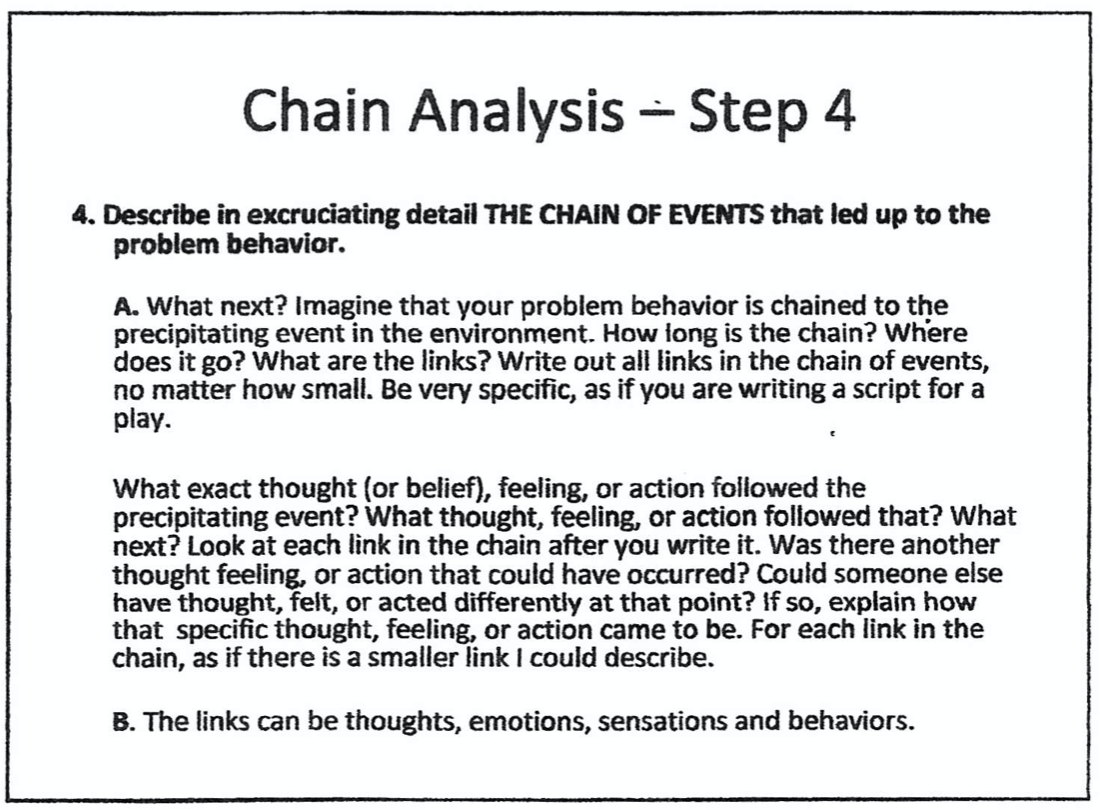Problem solving & behavior analysis
As I’ve been working through my DBT workbook, I have really tried to focus on problem-solving skills.
I’m a person who always likes to have a plan, or to be able to make a decision in that moment, or to try to solve the problem immediately.
However, I have changed this mindset and am looking to solve problems rationally, instead of solving them when I am overwhelmingly emotional.
The first problem solving skill I learned is the Opposite Action skill.
Basically–DOING THE OPPOSITE OF YOUR EMOTIONAL URGES.
There are usually good reasons for feeling whatever it is you feel. Even when they are painful, your emotions are legitimate and valid. The larger problem is emotion-driven behavior, because acting on emotions often creates destructive outcomes. For example, letting your anger cause you to attack other people with words can disrupt your relationships, while letting fear drive you to avoid critical tasks and challenges can interfere with your duties at work.
A second problem with acting on emotion-driven impulses is that they intensify your original feeling. Instead of getting relief, you may get even more consumed with the emotion if you act on your destructive urges. This is where opposite action comes in. Rather than fueling your emotion, opposite action helps regulate and change it.
Here are some examples of opposite action:
Notice that opposite action changes both body language—your posture and facial expression–as well as your actual behavior.
Opposite action isn't about denying or pretending an emotion isn't happening. Rather, it is about regulation. You acknowledge the emotion but use the opposite behavior to reduce it or encourage a new emotion.
There are six steps to creating opposite action… let’s go through them
Start by acknowledging what you feel. Describe the emotion in words.
Ask yourself if there's a good reason to regulate or reduce the intensity of this emotion. Is it overpowering you? Does it drive you to do dangerous or destructive things?
Notice the specific body language and behavior that accompany the emotion. What are your facial expression and your posture? "What are you saying and how are you saying it? it? What specifically do you do in response to the emotion?
Identify your opposite action. How can you relax your face and body so it doesn't scream "I'm angry” or ''I'm scared.” How can you change your posture to convey confidence and vitality rather than depression? How can you move toward, not away from, what scares you? When you’re angry, how can you acknowledge or ignore rather than rather than attack. Make a plan for opposite action that includes a specific description of your new behavior.
Fully commit to opposite action, and set a time frame to work at it. How long will you maintain the opposite behavior? As you think about making a commitment, keep in mind why you want to regulate your emotions. What's happened in the past when you gave in to emotion-driven behavior? Were there serious costs to you or to others?
Monitor your emotions. As you do opposite action, notice how the original emotion may change. Opposite action literally sends a message to the brain that the old emotion is no longer appropriate—and it helps you shift to a less painful emotion.
The second problem solving skill I learned is the ABC PROBLEM SOLVING method.
Sometimes emotion regulation has to start before the overwhelming feelings even begin. Problem solving focuses on identifying the triggering event and finding new, more effective ways to respond in the future. The first step to problem solving is to learn behavior analysis.
A. Alternatives. Brainstorm alternative responses. How could you change precipitating or secondary thoughts or behaviors ?
B. Best ideas. Evaluate your list and choose one or two of your best ideas to implement.
C. Commitment to implementation. Identify the time and place you’ll try your new responses. Write out the new thoughts or behaviors that you'll use in the future.
Behavior Analysis
Ultimately, problem solving begins with something called behavior analysis. Basically, this amounts to tracing the sequence (or chain) of events that led up to a problematic emotion. This will help you figure out where the reactions are coming from based on taking a deeper look into past events that have happened and may still be festering. It will help you understand why you acted the way you did, and then how you can change your behavior with this new level of awareness.
Below, I outlined the steps to help get you started with this skill!







